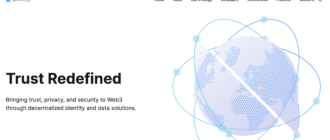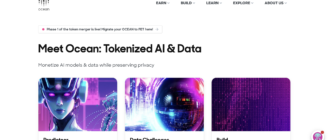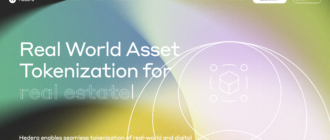Chainlink stands out in the crypto landscape as a decentralized oracle network designed to connect smart contracts on blockchain with external data sources, APIs, and payment systems. This allows smart contracts to interact with real-world data and events, enhancing their applicability and effectiveness.

History of the Project
Chainlink was created in 2017 by Sergey Nazarov and Steve Ellis. With the rising need for external data in the smart contract ecosystem, Chainlink proposed a solution to the “oracle problem” by ensuring that data fed into blockchains is secure and reliable. It quickly gained traction, leading to numerous partnerships with blockchain projects, data providers, and even with enterprises like Google and SWIFT. The development of Chainlink is managed by a core team, supported by various contributors and partners across the globe.
What is Chainlink?
Chainlink is a decentralized network of nodes that provide data and information from off-chain sources to on-chain smart contracts via oracles. It addresses the limitation of smart contracts which are unable to access external data themselves. Chainlink’s oracles serve as data feeds in smart contracts, which can be used to execute contracts based on inputs that can’t be monitored on the blockchain.
How Chainlink Works?
Chainlink is built upon a highly modular, decentralized design that allows it to effectively process data from external sources and securely feed it into various blockchain ecosystems. Here’s a detailed breakdown of its foundational technologies and their specific roles:
Decentralized Oracle Networks (DONs)
At the core of Chainlink’s operation are Decentralized Oracle Networks (DONs). Each DON consists of multiple independent oracles that work together to process data requests. This decentralization is crucial as it enhances the security and reliability of the data by mitigating the risk of a single point of failure, which is a common vulnerability in centralized systems.
Off-Chain Reporting (OCR)
Chainlink utilizes an innovative protocol known as Off-Chain Reporting. This mechanism allows multiple oracles to reach a consensus on data before it’s reported back to the smart contracts. This is significantly more efficient than having each oracle report data individually because it reduces the amount of transactional load on the blockchain, thereby lowering the gas fees and enhancing scalability.
Chainlink Core
The software that runs on each Chainlink node is known as Chainlink Core. This component is responsible for interfacing with the blockchain, processing data requests, and executing specified external assignments. It supports various functionalities, including but not limited to, data fetching, computation, and aggregation.
LINK Token and Staking
The LINK token plays a central role in the Chainlink ecosystem. It is used to incentivize node operators to perform efficiently and honestly. Chainlink plans to introduce staking, which will further secure the network by ensuring that node operators have a financial stake in the integrity of the data they provide.
Unique Consensus Mechanism
Chainlink does not operate its own blockchain but instead exists as a second-layer overlay on existing blockchains. Each DON can utilize different consensus mechanisms tailored to the specific data or request type. This flexibility allows Chainlink to be blockchain-agnostic, capable of serving multiple chains and thereby broadening its application scope.
Smart Contracts with Enhanced Capabilities
Chainlink smart contracts are designed to be highly flexible, allowing developers to customize the oracle to suit specific data requirements. This includes specifying the number of nodes, the aggregation model, and the sources of data. The adaptability ensures that smart contracts can effectively handle a variety of real-world applications ranging from financial services to supply chain management.
Distinctive Features
What sets Chainlink apart from other oracle services is its layer of abstraction that allows it to operate across different blockchains seamlessly. This interoperability is crucial for widespread adoption in various applications, as it enables smart contracts to utilize Chainlink oracles regardless of the underlying blockchain technology. Additionally, Chainlink’s focus on data integrity and security, through mechanisms like cryptographic proofs for data verification, positions it uniquely in the oracle market.
By integrating these technologies, Chainlink not only solves the oracle problem but does so in a way that ensures scalability, reliability, and security. Its technical foundation is designed to support a future where real-world data will increasingly interact with blockchains, making it a pivotal component in the broader blockchain ecosystem.
What are Oracles and Why Are They Necessary?
Oracles play a crucial role in the blockchain ecosystem, serving as bridges that connect blockchains with the outside world. Blockchains and smart contracts are inherently closed systems, limited to the data within their networks. They do not have the native ability to access or verify external data or events, which is a significant limitation for many practical applications. Oracles solve this problem by providing a reliable way to bring external data into the blockchain.
Functionality of Oracles
Oracles act as data feeds for smart contracts on blockchain platforms, enabling them to execute based on real-world inputs and events. This could include information like temperature, price fluctuations, flight or shipping statuses, and even sports results. Without oracles, smart contracts would be unable to interact with any data or event outside their network, severely restricting their use.
Types of Oracles
Oracles can vary widely in their design and source of data:
- Software Oracles: Handle data available online such as weather conditions, currency exchange rates, or flight statuses. They extract this data from websites and pass it into the blockchain.
- Hardware Oracles: Deal with data from the physical world. For example, sensors could provide real-time data about the physical condition of goods in transit, which could be used in a supply chain blockchain.
- Consensus Oracles: Aggregate data from multiple sources to ensure data reliability and accuracy before it is fed into the blockchain.
Importance of Oracles
The importance of oracles stems from their ability to expand the usability of smart contracts beyond simple token exchanges:
- Financial Services: Oracles enable smart contracts to execute transactions based on real-time financial data such as stock prices and currency exchange rates.
- Insurance: They can trigger automatic insurance payments based on data inputs that prove a claim, such as data from flight trackers or sensors that monitor environmental conditions.
- Supply Chain Management: Oracles provide data that ensures transparency and trust in supply chains, such as the location and condition of items, which can be recorded on a blockchain.
Oracles thus not only broaden the scope of applications for blockchain technology but also enhance the trustworthiness and efficiency of these applications by integrating accurate and real-time data. As blockchain technology continues to grow and evolve, the role of oracles will become increasingly fundamental in bridging the gap between decentralized digital systems and the complex, multifaceted real world.
Tokenomics of Chainlink
Chainlink utilizes a token, not a coin, named LINK. This distinction is important as LINK operates not as its own currency system (like Bitcoin or Ethereum with their respective coins), but as a digital asset within the Ethereum ecosystem, adhering to the ERC-677 token standard. This standard is an extension of ERC-20 that includes additional functionalities like data payload handling within transactions.
Token Utility and Function
LINK tokens are used primarily to facilitate the various functionalities within the Chainlink network, including compensating node operators for retrieving data, formatting data, uptime guarantees, and other off-chain services. This utility token approach ensures that each participant in the network is financially incentivized to act honestly and efficiently.
Token Supply and Emission
Chainlink’s total supply of LINK is capped at 1 billion tokens. This fixed supply model was established to prevent inflationary pressures and to maintain token value over time. The distribution of these tokens is predetermined:
- 35% was allocated to node operator incentives,
- 35% was sold during public and private sales,
- 30% remains within Chainlink for development.
This structured allocation supports the long-term development and operational costs of the Chainlink network while ensuring enough liquidity and incentives remain for node operators.
Market Dynamics and Pricing
The price of LINK is subject to market conditions and has experienced significant volatility, characteristic of many crypto assets. The demand for LINK correlates strongly with the adoption of Chainlink’s oracles and the overall market interest in decentralized finance (DeFi) applications. As DeFi platforms grow and require more external data feeds, the demand for LINK increases, potentially driving up its price.
Staking Mechanisms
Chainlink plans to implement staking mechanisms to further secure network operations and involve token holders in the network governance processes. Staking will likely enhance the intrinsic value of LINK by reducing available supply and providing stakers with rewards derived from network fees.
In summary, LINK’s role as a utility token within the Chainlink ecosystem, combined with its fixed supply and planned staking features, creates a robust economic framework. This framework not only supports the ongoing development and security of the network but also aligns the incentives of all participants towards the network’s long-term success and stability.
Where to Buy Chainlink Tokens
Chainlink’s LINK token is widely available on several major cryptocurrency exchanges, ensuring that investors and users have multiple options for acquiring LINK. Among the prominent exchanges offering LINK are:
- Binance: One of the largest and most popular cryptocurrency exchanges globally, Binance provides extensive trading pairs for LINK, including against major cryptocurrencies and fiat currencies.
- HTX (formerly Huobi): Known for its reliability and service breadth, HTX offers LINK trading and is popular among users in Asia.
- MEXC Global: This exchange is known for its wide range of cryptocurrencies, including LINK. It provides a user-friendly platform for both new and experienced traders.
- Bybit: Offers LINK trading in a modern trading environment with advanced trading features and tools.
- KuCoin: Popular for its user-friendly interface and competitive trading fees, KuCoin supports LINK trades against various crypto pairs.
- Bitfinex: Offers LINK and is known for its liquidity and advanced trading features, catering to more experienced traders.
These exchanges provide various tools for trading, including spot and futures markets, and offer different deposit methods, including bank transfers and credit card payments.
Where to Store Chainlink Tokens
When it comes to storing LINK tokens, users have several options ranging from hardware wallets to software wallets, depending on their security needs and convenience preferences. Here are the top choices:
- Hardware Wallets: For those seeking high-security storage for their LINK tokens, hardware wallets like Ledger Nano S, Ledger Nano X, and Trezor provide robust protection. These devices store tokens offline, significantly reducing the risk of hacking.
- Software Wallets: For ease of use and quick access, software wallets such as MetaMask, MyEtherWallet, and Trust Wallet are practical choices. These wallets run on smartphones or computers, offering an intuitive interface for managing LINK tokens.
- Mobile Wallets: Wallets like Trust Wallet and Coinbase Wallet on mobile devices offer a balance between convenience and security, allowing users to manage their LINK tokens directly from their smartphones.
- Web Wallets: Platforms like MetaMask also offer browser-based wallets, enabling quick interactions with decentralized applications directly from the web browser without the need for full node downloads.
Each storage option comes with its set of features like transaction signing, easy integration with exchanges, and in some cases, direct interaction capabilities with decentralized applications (DApps). Users should choose their storage solution based on their activity level, security concerns, and convenience requirements, always considering the trade-off between security and accessibility.
Future Prospects and Development Forecast
Growth Drivers
The growth of Chainlink is predominantly driven by its crucial role as a bridge between blockchain-based smart contracts and real-world data. As industries continue to explore and adopt blockchain technology for varied applications such as finance, insurance, supply chain, and gaming, the demand for reliable, real-time data feeds has surged. Chainlink’s unique capability to securely and efficiently provide this data positions it as a central figure in the expansion of blockchain applications.
Clients and Partnerships
Chainlink has established an impressive array of partnerships across various industries, which is a testament to its utility and adaptability. Notable partnerships include:
- Google Cloud: Integrating Chainlink to make cloud data available to developers on blockchain platforms.
- Oracle: Collaborating to help monetize APIs via Chainlink’s network.
- SWIFT: Working together to allow SWIFT to directly interface with Chainlink-enabled smart contracts.
- Docusign: Using Chainlink’s network to verify signatures in smart contracts.
These partnerships not only broaden Chainlink’s applicability and usage but also enhance its credibility and market presence in the blockchain ecosystem.
Development Forecast
The development trajectory for Chainlink is set to focus on expanding its functionality and interoperability with other blockchain platforms. Plans for Chainlink 2.0 involve innovations such as enhanced scalability solutions, privacy features for preserving data confidentiality, and more advanced off-chain computations. The roadmap also suggests further development in creating a more robust and economically scalable oracle network, which could significantly enhance the platform’s efficiency and reduce operational costs.
Chainlink’s Ecosystem
Chainlink’s ecosystem encompasses a wide range of components and contributors which include:
- Node Operators: Individuals and companies who operate the hardware necessary to provide data to the Chainlink network.
- Data Providers: Entities that supply real-time data feeds that Chainlink oracles utilize to connect smart contracts to the real world.
- Smart Contract Developers: Programmers who create contracts that utilize Chainlink to incorporate external data feeds.
- Research Partners: Academic and technological research institutions that collaborate with Chainlink to improve and innovate on its technology.
- Integration Partners: Blockchain platforms that integrate Chainlink to enhance their own ecosystems with external data capabilities.
This rich and diversified ecosystem is fundamental to Chainlink’s continuous improvement and adoption, providing a stable foundation for growth. As the blockchain sector evolves, Chainlink’s expansive and robust ecosystem, along with its strategic partnerships, position it well to capitalize on future opportunities and challenges in the decentralized finance and wider blockchain spaces.
Conclusion
Chainlink represents a critical component in the blockchain ecosystem, enabling smart contracts to effectively interact with the outside world. Its innovative approach to solving the oracle problem provides a robust foundation for the future, where real-world data will play a pivotal role in the operation of decentralized applications. Advanced users and investors in the crypto space find Chainlink’s technology and strategic potential to be of considerable interest due to its capacity to enhance the functionality and reach of blockchain technology.






